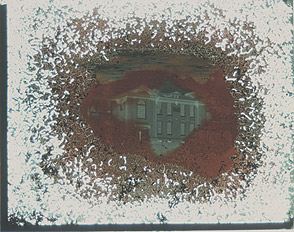
glass supports
In the mid-19th century, photographic negatives and transparencies (positive images) began to use glass as a support. Glass provided a sharper negative and a more detailed positive print, and soon replaced paper negatives. Like photographic prints, glass negatives and transparencies are composite objects, consisting of a glass support, a binder, an image-forming or recording substance, and, in some cases, a cover glass.
Common Formats
The lantern slide (a positive image that could be projected onto a surface so a group of people could see it) was invented in 1849. Lantern slides were often hand-colored and had a glass covering, which was taped around the edges. Lantern slides were in use until the middle of the 20th century, when smaller transparencies on film were introduced. Eventually lantern slides were completely replaced by 35mm color slides. The autochrome process (offered commercially in 1907), also produced a positive image on glass. Dyed starch grains were applied to a varnished glass plate, with a silver halide emulsion then applied on top. Once the plate was exposed and developed, it was varnished and given a cover glass.
In 1851 the collodion glass plate negative was introduced, which used glass as a support and collodion as a binder (these were also known as wet-plate negatives, because it was necessary to expose and process the glass plate while the binder and sensitizing solution were still wet). During the 1870s gelatin dry plate negatives, which used a glass support and a gelatin binder, became commercially available. These eventually replaced collodion glass plate negatives because they required less exposure time and the plates did not have to be developed in the field. Gelatin dry plate negatives allowed for the production of ready-to-use glass plates with a longer shelf life than collodion glass plate negatives. Gelatin dry plate negatives were gradually replaced by nitrate film negatives and were rare after the late 1920s.
Characteristic Types of Deterioration
|
|
The flaking of the emulsion layer from the glass plate is frequently seen. In glass collodion and gelatin dry plate negatives, the binder sometimes peels away from the plate if the plate was not properly cleaned. The most common type of damage to glass plates, however, is breakage due to poor handling.
Collodion glass plate negatives and early gelatin dry plate negatives were also sometimes vulnerable to chemical decay due to excess amounts of alkaline chemicals in the glass. This type of glass was termed soda or soda-lime glass. This chemical decay is known as alkali leaching or "weeping glass." At high relative humidity, the surface of the glass develops an alkaline hydrated layer (this manifests as moist droplets) that can damage the binder and the silver image. If the moisture remains on the glass for some time, a fine network of cracks (called crizzling) can develop on the surface. By the 1920s, the addition of aluminum oxide resulted in more chemically stable glass. Weeping glass is also frequently found in daguerreotypes.

